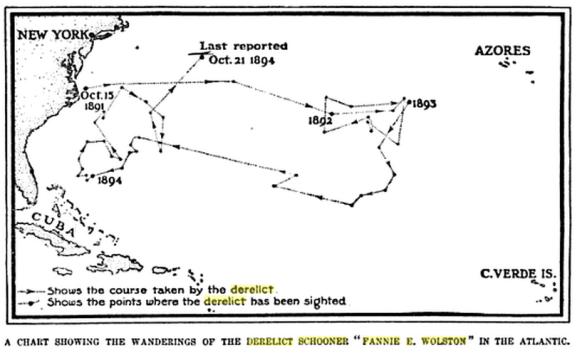 One of the more interesting questions about Louis Jordan’s ordeal is “why didn’t he drift farther north on the Gulf Stream?” Jordan was dismasted in his Alberg 35 sailboat, named Angel, somewhere off the North Carolina coast in January and drifted for 66 days until he was spotted by a German container ship roughly 200 miles east of the North Carolina shore. Jordan was somewhat north of where he entered the Atlantic but the primary direction that his boat drifted, dismasted and with a damaged rudder, was easterly. How is this possible?
One of the more interesting questions about Louis Jordan’s ordeal is “why didn’t he drift farther north on the Gulf Stream?” Jordan was dismasted in his Alberg 35 sailboat, named Angel, somewhere off the North Carolina coast in January and drifted for 66 days until he was spotted by a German container ship roughly 200 miles east of the North Carolina shore. Jordan was somewhat north of where he entered the Atlantic but the primary direction that his boat drifted, dismasted and with a damaged rudder, was easterly. How is this possible?
The best answer I have is, “I don’t know.” The Gulf Stream averages around 4 knots. If it was a simple conveyor belt heading north-east, then Angel should have traveled the 3,200 miles and have hit Ireland after around 33 days. It doesn’t appear to be that simple, however. There are counter currents closer to shore that might have first carried Angel south. There are large eddies that form on the edges of the Gulf Stream that might have prevented the boat from drifting north.
Jordan’s boat Angel is still out there, a derelict, drifting on the currents and potentially posing a hazard to navigation other boats. Angel is, of course, not a the first or last derelict lost off Cape Hatteras. Looking at the path of other derelict vessels in history might give us an idea as to why the Angel drifted as she did.
One interesting case was that of the three masted lumber schooner Fannie E Wolston which was abandoned off Cape Hatteras in 1891, not far from where Louis Jordan drifted on Angel. She was observed by dozens of other ships over the next three years.
Which way did the Fannie E Wolston drift? For the first year, almost due east, then south-east. For the next year she drifted in circles in the mid-Atlantic before drifting west again, did one more loop before drifting north and east, finally seeming to ride the current of the Gulf Stream before finally being sighted for the last time on October 21, 1894. It is estimated that she drifted almost 9,000 nautical miles before she finally disappeared.
Why did the Fannie E Wolston drift eastward rather than north-east on the Gulf Stream? Again, I don’t have a good answer, but her track was reasonably well documented. Did Angel drift on a similar course? Possibly. Has Angel sunk or is she still drifting? No one really knows.
To learn more about derelicts in the Age of Sail, check out “Derelicts – a Menace of the Age of Wooden Ships“ on Antione Vanner’s blog, The Dawlish Chronicles. While you are at it, check out his latest novel, Britannia’s Shark.

Hm, missed this the first time. But a bundle of life jackets from BOUNTY were found about due east from the sinking just north of Bermuda months later.
The currents in that part of the Atlantic are hard to predict because the Labrador Current hits the Gulf Stream and there are numerous counter currents and eddies that can carry boats and anything floating floating in almost any direction.
Thought you may be interested in this PDF that incorrectly names the Fannie as Annie III but none the less the same brig I feel.
http://www.hms-worcester.org.uk/page64.html
PDF
http://www.hms-worcester.org.uk/stuff/Contributions/FL%20Moth.pdf
The PDf is the story of an OWs voyages on the Taranaki square rigger and the reference to the Fannie is on page 6
Thanks. Very interesting.